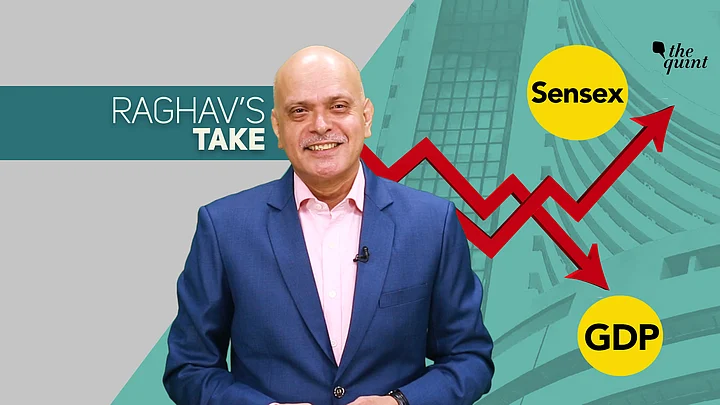Coal output crashes by over 20 percent; refinery products, crude oil and natural gas shrink 5-6 percent apiece; electricity production down by nearly 4 percent; overall, eight core sectors lose a stunning 5.2 percent year-on-year over September 2018, contracting to an 8-year low.
Industry borrows Rs 1 lakh cr less than last year; services forego Rs 50,000 cr in bank credit.
And yet, India’s stock markets hit an all-time high!
All the above inconsistencies/contradictions surfaced on the same day, ie on Thursday, 31 October 2019. Why, you ask?
To understand this conundrum, we shall have to dial back a few months, to the first quarter of this calendar year, as Prime Minister Modi began his re-election campaign for May 2019. As was but natural, he energetically talked up the economy, hardening the widely held perception that his first term had created a strong momentum, give or take a couple of hiccups. However, the subterranean data points showed a severely challenged macro picture. Here, take a look.
Everybody thought Prime Minister Modi’s political Teflon would get dented by a flailing economy. Of course, nobody seriously expected him to lose, but only for his 2014 mandate to get abbreviated. But he shocked the whole world by improving upon his tally, crossing a breath-taking 300 seats in Lok Sabha. The markets broke into a euphoric dance of crazy expectations. Surely, he would use his vastly enhanced political capital to finally essay deep, difficult reforms to unshackle the economy, once and for all, right?
No, wrong.
The second Modi government’s first budget was alarmingly status-quoist. It was an unusual tax-and-spend document. Among several excesses, it unwittingly brought foreign investors under a “super rich tax” of nearly 43 percent. When that “error” was pointed out, the finance minister brushed it off, saying, in a manner of speaking: “please go figure this out for yourself. Change corporate structures, whatever, but what we’ve done is done. It’s now your problem if you want to do business in India”.
Spurned and panicky, foreign investors voted with their feet. The markets tossed over into a free fall, tumbling nearly 10 percent, threatening to test much lower bottoms. That’s when the government learned a fatal lesson – the Modi magic can bewitch an electorate, vow foreign leaders, but simply cannot forestall the market’s fury.
Wrath of Markets Inspired ‘Disruptive’ Policies
So, even an indomitable Prime Minister had to bow before the wrath of markets. He had to roll out the tanks to buy peace. He cut India’s corporate tax rate by an eye-rubbing 10 percentage points in one swish of the axe. For new manufacturing companies, it was slashed to around 17 percent, perhaps the lowest and most competitive rate on earth for an economy of comparable opportunities.
Finally, PM Modi, accused by The Economist of being a “tinkerer”, had chosen to “show ‘em” that he could think and act “disruptive”. Predictably, the world sat up and took notice. The government also admitted its mistake in levying the “super tax” on foreign investors. The markets abruptly changed course, climbing to record highs within weeks of acknowledging a “turbo charged” government.
Ever since the u-turn, the government has been accelerating in the reverse direction. It is talking about hitherto unthinkable actions. For instance:
- The purported decision to sell BPCL to a private acquirer for close to $ 10 bn
- To consider rolling back the egregious taxation of equity capital by killing dividend distribution and long-term capital gains taxes
- To acknowledge that it had set stubborn my-way-or-the-highway conditions on the sale of Air India in the last round; and now, making it far more doable by permitting a 100 percent equity sale, transferring the debilitating debt burden out of the carrier’s balance sheet, allowing it to lay off people, change the brand and get merged with the acquirer. These concessions were once thought to be impossible
- The fact that the usually remote/unreachable Telecom Ministry could be open to giving some relief to telcos reeling under the SC’s AGR (Adjusted Gross Revenue) levies – something that may have been heretical in earlier times
So, Has the Government Given up its Obscurantist Policies for Good?
Fully and completely endorsed a competitive and market-friendly policy architecture? Unfortunately, NO:
- Just look at what the same Telecom Ministry is doing with comatose public sector entities like BSNL and MTNL. It is merging two dying companies, giving them an anaesthetic infusion of Rs 70,000 cr, which will eventually create a giant corpse
- How it is blindly refusing to understand that allowing systemically important finance companies to fail – eg, ILFS last year, perhaps DHFL this year – creates a disorderly trauma for ordinary citizens. But if these very assets are saved, while only errant owners/managers are punished, public welfare is enhanced, not diminished
- Instead of fixing the deep-rooted malaise of public sector banks, it is creating the illusion of “reform” by changing, chopping, merging bad balance sheets, but that’s only getting the patient off the ventilator and into the ICU
It’s this lingering dissonance/confusion in the government’s policies – exemplified so graphically by its stance on BPCL versus BSNL/MTNL – that is radiating a larger dissonance through the economy. And that’s why the markets are at a record high, while key sectors are reeling in pessimism.
It’s now time to kill the dissonance and move “one way” on the highway to bold reforms.
(At The Quint, we question everything. Play an active role in shaping our journalism by becoming a member today.)
